Apple iPad 2 Preview
by Anand Lal Shimpi, Brian Klug & Vivek Gowri on March 12, 2011 6:01 AM ESTI remember the speculation that lead up to Apple's iPad launch. The list of things everyone expected the device to do was absurd, and the theories on the architecture behind Apple's first branded SoC was just as fantastic. The simplest answer is sometimes the right one and as Ars Technica's Jon Stokes pointed out, the A4 was nothing more than a hardened ARM Cortex A8 core running at 1GHz in the iPad (and 800MHz in the iPhone 4).

The Cortex A8 is something we've covered extensively here so I won't go into great detail right now. It's a dual-issue, in-order architecture with a 13 stage integer pipeline and a non-pipelined FPU.
When Apple announced the iPad 2, it also briefly announced the A5 SoC. The only detail given? The A5 is a dual-core processor with a GPU that's 9x faster than what's in the A4.

There are only two recent ARM architectures that have multicore support: the ARM11 and the ARM Cortex A9. The A8 doesn't come in a multicore variant. Given how many other SoC vendors are shipping dual-core Cortex A9 SoCs, the A5 was likely no different than NVIDIA's Tegra 2, TI's OMAP 4 or Samsung's Exynos in that regard: armed with a pair of Cortex A9s running at 1GHz. Update: Geekbench reports clock speed at 900MHz. Update 2: Apple confirms 1GHz clock speed on the iPad 2 specs page.
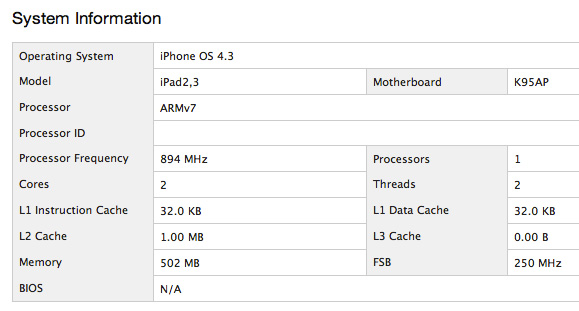
| Architecture Comparison | |||||||
| ARM11 | ARM Cortex A8 | ARM Cortex A9 | Qualcomm Scorpion | ||||
| Issue Width | single-issue | dual-issue | dual-issue | dual-issue | |||
| Pipeline Depth | 8 stages | 13 stages | 9 stages | 13 stages | |||
| Out of Order Execution | N | N | Y | Partial | |||
| FPU | Optional VFPv2 (not-pipelined) | VFPv3 (not-pipelined) | Optional VFPv3-D16 (pipelined) | VFPv3 (pipelined) | |||
| NEON | N/A | Y (64-bit wide) | Optional MPE (64-bit wide) | Y (128-bit wide) | |||
| Process Technology | 90nm | 65nm/45nm | 40nm | 40nm | |||
| Typical Clock Speeds | 412MHz | 600MHz/1GHz | 1GHz | 1GHz | |||
The Cortex A9 is similar to the A8 but with an out-of-order execution engine and a shallower pipeline (9 stages). The result is better-than-A8 performance at the same clock speed. The A9 also adds a fully pipelined FPU.
Now it's unclear what the rest of the A5 SoC looks like, but from the CPU standpoint I think it's safe to say that there are a pair of ARM Cortex A9s in there. We can look at the increase in Geekbench Floating Point scores for some proof:
| Geekbench 2 - Floating Point Performance | ||||
| Apple iPad | Apple iPad 2 | |||
| Overall FP Score | 456 | 915 | ||
| Mandlebrot (single-threaded) | 79.5 Mflops | 279.1 Mflops | ||
| Mandlebrot (multi-threaded) | 79.4 Mflops | 554.7 Mflops | ||
| Dot Product (single-threaded) | 245.7 Mflops | 221.7 Mflops | ||
| Dot Product (multi-threaded) | 247.2 Mflops | 436.8 Mflops | ||
| LU Decomposition (single-threaded) | 54.5 Mflops | 205.4 Mflops | ||
| LU Decomposition (multi-threaded) | 54.8 Mflops | 421.6 Mflops | ||
| Primality Test (single-threaded) | 71.2 Mflops | 177.8 Mflops | ||
| Primality Test (multi-threaded) | 69.3 Mflops | 318.1 Mflops | ||
| Sharpen Image (single-threaded) | 1.51 Mpixels/s | 1.68 Mpixels/s | ||
| Sharpen Image (multi-threaded) | 1.51 Mpixels/s | 3.34 Mpixels/s | ||
| Blur Image (single-threaded) | 760.2 Kpixels/s | 665.5 Kpixels/s | ||
| Blur Image (multi-threaded) | 753.2 Kpixels/s | 1.32 Mpixels/s | ||
Single threaded FPU performance is multiples of what we saw with the original iPad. This sort of an improvement in single-core performance is likely due to the pipelined Cortex A9 FPU. Looking at Linpack we see the same sort of huge improvement:
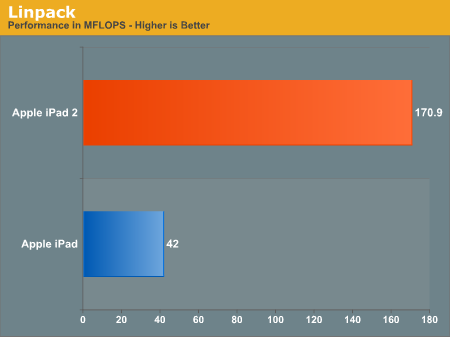
Whether this performance advantage matters is another matter entirely. Although there aren't many FP intensive iPad apps available today, moving to the A5 is all about enabling developers - not playing catch up to software.
Memory size, bandwidth and operating frequencies are all unknowns that I was hoping to find out more about once I put hands on the iPad 2. Geekbench reports the iPad 2 at 512MB of memory, double the original iPad's 256MB. Remember that Apple has to deal with lower profit margins than it'd like with the iPad, but it refuses to cut corners on screen quality so something else has to give.
L2 cache size has also apparently increased from 512KB to 1MB. The L2 cache is shared among both cores and 1MB seems to be the sweet spot this generation.
| Geekbench 2 - Memory Performance | ||||
| Apple iPad | Apple iPad 2 | |||
| Overall Memory Score | 644 | 787 | ||
| Read Sequential (single-threaded scalar) | 340.6 MB/s | 334.2 MB/s | ||
| Write Sequential (single-threaded scalar) | 842.4 MB/s | 1.07 GB/s | ||
| Stdlib Allocate (single-threaded scalar) | 1.74 Mallocs/s | 1.86 Mallocs/s | ||
| Stdlib Write (single-threaded scalar) | 1.20 GB/s | 2.30 GB/s | ||
| Stdlib Copy (single-threaded scalar) | 740.6 MB/s | 522.0 MB/s | ||
Geekbench's memory tests show an improvement in effective bandwidth as well. The biggest improvement is in the stdlib write test which shows a near doubling of bandwidth from 1.2GB/s to 2.3GB/s. Unfortunately this isn't enough data to draw conclusions about bus width or DRAM operating frequency. Given the increases in CPU and GPU performance, an increase in memory bandwidth to go along with the two isn't surprising.
Geekbench shows a healthy increase in integer performance, both in single and multithreaded scenarios. The multithreaded advantage makes sense (two are better than one), but the lead in single threaded tests shows the benefit the A9 can deliver thanks to its shorter pipeline and ability to reorder instructions around stalls.
| Geekbench 2 - Integer Performance | ||||
| Apple iPad | Apple iPad 2 | |||
| Overall FP Score | 365 | 688 | ||
| Blowfish (single-threaded) | 13.9 MB/s | 13.2 MB/s | ||
| Blowfish (multi-threaded) | 14.3 MB/s | 26.1 MB/s | ||
| Text Compression (single-threaded) | 1.23 MB/s | 1.50 MB/s | ||
| Text Compression (multi-threaded) | 1.20 MB/s | 2.82 MB/s | ||
| Text Decompression (single-threaded) | 1.11 MB/s | 2.09 MB/s | ||
| Text Decompression (multi-threaded) | 1.08 MB/s | 3.28 MB/s | ||
| Image Compress (single-threaded) | 3.36 Mpixels/s | 3.79 Mpixels/s | ||
| Image Compress (multi-threaded) | 3.41 Mpixels/s | 7.51 Mpixels/s | ||
| Image Decompress (single-threaded) | 6.02 Mpixels/s | 6.68 Mpixels/s | ||
| Image Decompress (multi-threaded) | 5.98 Mpixels/s | 13.1 Mpixels/s | ||
| Lua (single-threaded) | 172.1 Knodes/s | 273.4 Knodes/s | ||
| Lua (multi-threaded) | 171.9 Knodes/s | 542.9 Knodes/s | ||
On average Geekbench shows a 31% increase in single threaded integer performance over the A4 in the original iPad. NVIDIA told me they saw a 20% increase in instructions executed per clock for the A9 vs. A8 and if we remove the one outlier (text decompression) that's about what we see here as well.
| Geekbench 2 | |||||||
| Overall | Integer | FP | Memory | Stream | |||
| Apple iPad | 448 | 365 | 456 | 644 | 325 | ||
| Apple iPad 2 | 750 | 688 | 915 | 787 | 324 | ||
The increases in integer performance and memory bandwidth are likely what will have the largest impact on your experience. The fact that we're seeing big gains in single as well as multi-threaded workloads means the performance improvement should be universal across all CPU-bound apps.
What does all of this mean for performance in the real world? The iPad 2 is much faster than its predecessor. Let's start with our trusty javascript benchmarks: SunSpider and BrowserMark.
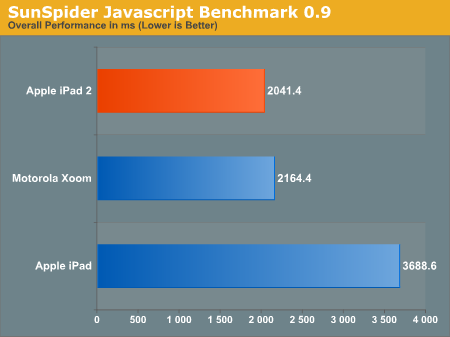
Apple improved the Safari JavaScript engine in iOS 4.3, which right off the bat helped the original iPad become more competitive in this test. Even with both pads running iOS 4.3, the iPad 2 is 80% faster than the original iPad here.
The Motorola Xoom we recently reviewed scored a few percent slower than the iPad 2 in SunSpider as well. Running different OSes and browsers, it's difficult to conclude much when comparing the A5 to Tegra 2.
A bug in BrowserMark kept us from running it for the Xoom review but it's since been fixed. Again we're looking at mostly JavaScript performance here. Rightware modeled its benchmark after the JavaScript frameworks and functions used by websites like Facebook, Amazon and Gmail among others. The results are simply one aspect of web browsing performance, but an important one:

The move from the A4 in the iPad 1 to the A5 in the iPad 2 boosts scores by 47%. More impressive however is just how much faster the Xoom is here. I suspect this has more to do with Google's software optimizations in the Honeycomb browser than hardware, but let's see how these tablets fare in our web page loading tests.
We debuted an early version of our 2011 web page loading tests in the Xoom review. Two things have changed since then: 1) iOS 4.3 came out, and 2) we changed our timing methods to produce more accurate results. It turns out that Honeycomb's browser was stopping our page load timer sooner than iOS', which resulted in some funny numbers when we got to the 4.3/Honeycomb comparison. To ensure accuracy we went back to timing by hand (each test was repeated at least 5 times and we present an average of the results). We also added two more pages to the test suite (Digg and Facebook).

The iPad 2 generally loads web pages faster than the Xoom. On average it's a ~20% increase in performance. I wouldn't say that the improvement is necessarily noticeable when surfing most sites, but it's definitely measurable.
The move to iOS 4.3 really narrowed the gap between the original iPad and the Xoom. In some cases the two actually render pages in the same amount of time, however that's typically for lighter pages that are easy to render. Up the complexity and the Xoom easily distances itself from the original iPad.
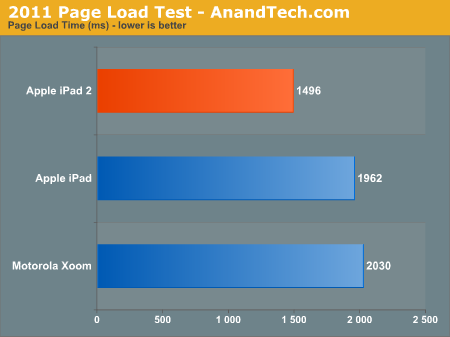
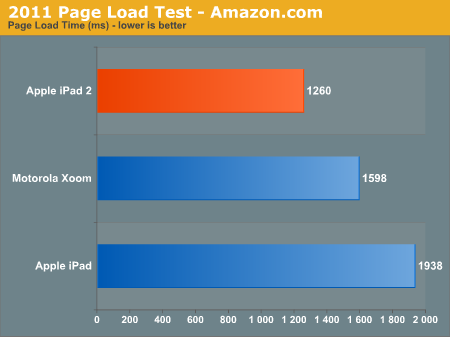
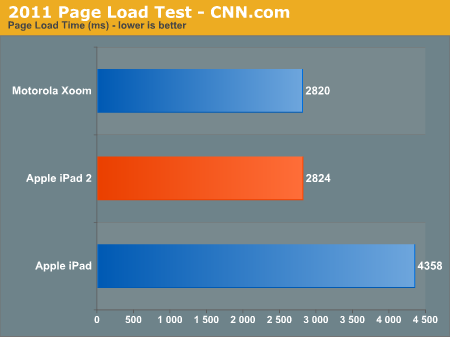

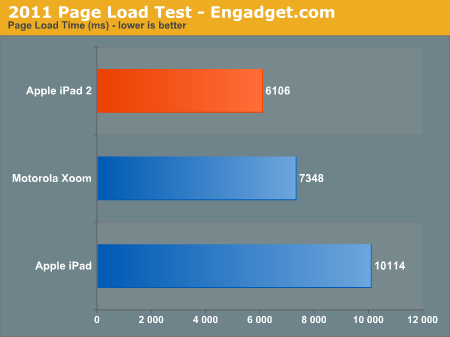

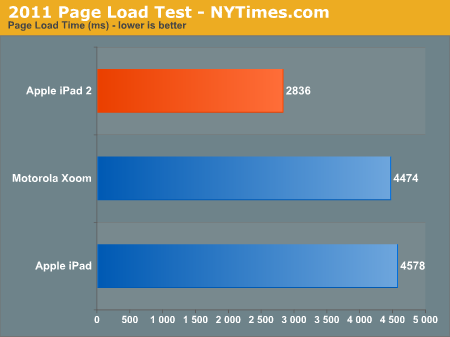
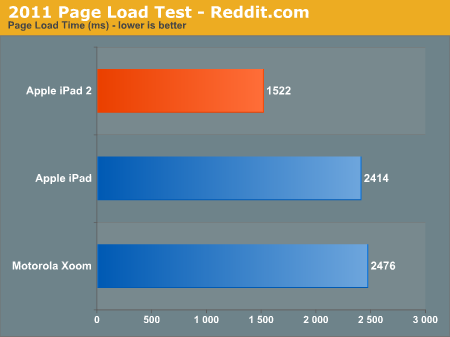
We'll touch on this more in the full review but it's not all about performance when talking about web browsing between the iPad 2 and the Xoom. Although the iPad 2 may have faster render times on average, the Xoom still supports tabbed browsing which definitely has its advantages.










82 Comments
View All Comments
Seurahepo - Sunday, March 13, 2011 - link
Is there a problem with the comment system? This comment looks like it was from March 2010. :)Joking aside, I am not sure what you are comparing iPad with, but it is hard to see how it would be huge and bulky. Sure it is bigger than your cell phone, but it also gives you about seven times the screen area (comparing iPhone and iPad), which makes a big difference to how apps should make the layout and how gestures work.
You claim people purchasing iPads (and other tablets?) are stupid, which would be the better choice for them? Mobile phone? netbook? laptop? something else? Another tablet, just not from Apple?
Web browsing is one thing you can do with it, you can do your mail, you can play games etc. But the main thing is *apps*, which app is the killer app for you, I cannot know, but there are 65 thousand already out there and the number is growing. iPad like tablets is the future platform for a big group for apps. Not Windows PC or even Macs, those are the dinosaurs of the past, post PC-era is here.
vision33r - Saturday, March 12, 2011 - link
If it's pointless device to you then why do you bother reading this article and make complaints about it?Seems you got some anxiety or insecurities to work on.
Same question can be asked about anything in this world.
What's the point with a convertible sports car?
Why do some people use a briefcase and not a backpack?
sean.crees - Sunday, March 13, 2011 - link
Majority of my time lately online seems to be reading web pages, watching video's, checking email, listening to music.All of which is much more convenient on an Ipad. Notebooks are bulky to walk around with because of the attached keyboard. Smartphones are too small to clearly see what it is your doing. Smartphones may "work", but tablets make it more enjoyable.
So what i end up with is the freedom of a smartphone with the display size of a small notebook. Best of both worlds IMO.
I may not be able to put it in my pocket, but at least i don't need a chair to use it like a laptop. Have you ever tried using a laptop in your hands while you walk around with it? Its incredibly difficult.
While the ipad may not fit in my pocket, its small and light enough that i wouldn't mind just holding it in my hands as i walk around, or tossing it in a backpack/purse, or perhaps even getting a larger pocket sewn into the inside pocket of a jacket.
NCM - Monday, March 14, 2011 - link
Over 15 million buyers seem to have figured out the point of the original iPad, enough to pay $500 or more for one. Rather a lot to ascribe to mass hysteria. Maybe it's something in the water?Or did we somehow miss the news reports about hordes of disgruntled buyers demanding refunds for their "pointless" devices?
nitrousoxide - Saturday, March 12, 2011 - link
Please explain me this: In your XOOM review, it loads AnandTech.com in 603.1ms while it takes 2000+ms in this preview. Have you changed your benchmark suite?Anyway I believe that Google's Android is simply a waste of hardware power. It's a poorly optimized OS, no matter Gingerbread or Honeycomb. The only way for it to keep up with iOS or Windows Phone is using superfast chips but when that hardware advantage is gone, it stands no chance.
Seurahepo - Sunday, March 13, 2011 - link
Yes, they changed back to hand timing, because the results from the Android browser were strange.name99 - Saturday, March 12, 2011 - link
"The iPad 2 maintains full 5 GHz (802.11a/n) support, "This is not so. As far as I can tell, for example, 5GHz 40MHz channels are not supported. This is the big one. I don't have the kit to test it, but it would not surprise me short guard intervals and some of the other optional protocol niceties that buy you a few percent (to, sometimes many 10s of percent) here and there are also not supported.
More generally, might I make a plea that you institute some sort of standardized benchmark for testing the quality of WiFi (and 3G, though for iPad I care about this less) implementations?
The reason I ask is that
- for reasons I don't understand Apple (quietly and behind the scenes) seems to keep pushing to always have better wireless kit than the competition (eg 3 active antennas in the newest MacBook Pros and Airport Base Station) while the competition lag BUT
- the quality of wireless in these devices is an easy target for improvement right now, adding in more antennas and smarter decoding algorithms.
In other words, it seems to me that an OBVIOUS way for the next great tablet to differentiate itself from iPad2 is through having multiple antennas (both WiFi and 3G) hooked up to competent firmware and OS code, such that it could achieve double or better WiFi bandwidth, and a much more robust WiFi and 3G experience.
It would be nice, if this happens, for AnandTech to be able to verify the truth of the (doubtless exaggerated) statements the marketers will make, and more generally to play the same role here that it has played in SSDs in just pushing awareness of the state of the art forward and not allowing manufacturers to get lazy. (I'd regard, for example, Apple's unwillingness to boost the WiFi here over iPad1 as an example of being lazy because they can get away with it. They have no competition in the tablet space, and it's not something reviewers look at carefully and complain about.)
Seurahepo - Sunday, March 13, 2011 - link
While making a better wifi implementation may seem like an obvious way of differentiating from iPad it is far from it. Better networking implementation is very hard to market for the general population. The only viable way seems to be marketing by buzzword, marketing the same buzzword with "better implementation" will be hard.For the non-geek the speed is often more than enough, they are used to the fact that computers take their time. And even if they found it to be slow, they would not know what is the reason.
Brian Klug - Monday, March 14, 2011 - link
So the iPad 1 and 2 both only support the long guard interval (65 Mbps) MCS on both 2.4 and 5 GHz channels, with only 20 MHz support.I consider this "full" mobile support only because the majority of "802.11n" mobile devices do the same thing - 65 Mbps, or in rare circumstances short guard interval 72 Mbps.
Keep in mind, the iPad 1 already was the differentiating product, as it was the first smartphone/tablet that came with 5 GHz support at all. The myTouch 4G and Galaxy S 4G both also have 802.11a/n support with 72 Mbps.
I've definitely been testing/pushing for more/better antenna and connectivity, and it's interesting that Apple chose to essentially keep the same WiFi stack as they had in the previous version. That said, baseband has definitely improved ;)
-Brian
btdvox - Saturday, March 12, 2011 - link
I disagree with your comment on the White iPad, I had a choice between the White 32 and Black 32, and after seeing demo models of both yesterday, it's clear the White looks very cheap, the Service Rep told me it's actually not covered with glass but rather the components of the white macbook and can be prone to staining.Sure it doesn't show finger prints, but watch any movies, and websites that use dark schemes (Which every movie does and most websites do), even the top bar is black (status bar), and with a black bezel, these components all "seam" together, and even the hardware (things like the light sensor, camera etc, are barely visible).
With the White bezel all these components make the ipad less seamless and I thought the display on the white looked worse, simply because of it's bezel.
The same goes for TV's, would you rather watch a movie on a TV with a white or grey bezel or a glossy black one? I'll always choose glossy blacks, it makes the display look better.
Still pictures suck on the ipad 2, just like they do on the ipod gen 4 but Video is really good, on par with iphone 4! Sucks that they didn't spend the same components on the iPad 2 camera, wish they did!! No autofocus kind of sucks too!